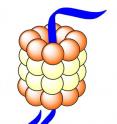Harmful amyloid interferes with trash pickup for cells in Alzheimer's disease
Chemists at the University of California, San Diego, have identified how a protein that accumulates in the brains of people with Alzheimer's disease interferes with the ability of cells to get rid of debris. They also found a natural mechanism by which this protein, amyloid beta, itself may be discarded. Plaques of amyloid are a hallmark of the ailment, but no one is sure exactly how they contribute to catastrophic loss of memory and cognition.
Scientists have begun to suspect that amyloid disables a structure called a proteasome, which chops up proteins that cells no longer need into pieces that can be reused or discarded. Proteins that have been tagged for destruction pile up in the brains of Alzheimer's patients.
"Basically the trash is put out to the curb, but no one is picking it up," said Jerry Yang, an associate professor of chemistry and biochemistry who led the research effort.
Yang and postdoc Xiaobei Zhao showed that amyloid actually doesn't harm the proteasome. Instead it interferes with the processing of other proteins by competing for access, they report in a forthcoming issue of the journal ACS Chemical Neuroscience.
They found that the proteasome breaks long chains of toxic amyloid into smaller, harmless pieces. And because the proteasome has a greater affinity for amyloid, other proteins build up undigested.
"The fact that the proteasome can hack up amyloid fairly efficiently gives us some insight as to how normal clearance mechanisms actually work," Yang said. "We all have amyloid peptides, and we all get rid of them as well. The proteasome is in every cell."
Scientists believe amyloid plays a central role in the development of Alzheimer's disease and that an imbalance between production and clearance of amyloid leads to build up and the formation of plaques. But they aren't certain how amyloid is normally broken down and removed from the brain.
"Relatively little attention has been paid to how you get rid of it," Yang said. "Minimally, this finding reveals a little bit more about what the amyloid is doing within the cell – how it's altering the function of this very important piece of machinery. If proteasomal dysfunction turns out to be a primary factor in Alzheimer's disease then this will be a key finding."
Source: University of California - San Diego
Articles on the same topic
- Function found for Alzheimer's proteinFri, 10 Sep 2010, 18:43:33 UTC
- Strategy discovered to prevent Alzheimer's-associated traffic jams in the brainThu, 9 Sep 2010, 21:16:20 UTC
- New compound safely reduces plaques in mouse model of Alzheimer's diseaseWed, 8 Sep 2010, 19:16:04 UTC
- Neurogenetic studies show proprietary compound reduces brain plaques linked to Alzheimer'sWed, 8 Sep 2010, 19:16:02 UTC
- Researchers identify potential new drug for neurodegenerative diseaseWed, 8 Sep 2010, 17:30:30 UTC
- Compounds fend off Alzheimer's disease amyloid pathologyWed, 8 Sep 2010, 16:37:17 UTC
Other sources
- Function found for Alzheimer's proteinfrom PhysorgFri, 10 Sep 2010, 21:21:09 UTC
- Function found for Alzheimer's proteinfrom Science DailyFri, 10 Sep 2010, 20:21:07 UTC
- Function found for Alzheimer’s proteinfrom Science BlogFri, 10 Sep 2010, 19:21:07 UTC
- Strategy discovered to prevent Alzheimer's-associated traffic jams in the brainfrom Science DailyThu, 9 Sep 2010, 22:14:08 UTC
- Strategy discovered to prevent Alzheimer's-associated traffic jams in the brainfrom PhysorgThu, 9 Sep 2010, 21:56:29 UTC
- Strategy discovered to prevent Alzheimer’s-associated traffic jams in the brainfrom Science BlogThu, 9 Sep 2010, 21:14:11 UTC
- New compound safely reduces plaques in mouse model of Alzheimer's diseasefrom Science DailyWed, 8 Sep 2010, 19:14:23 UTC
- Potential new drug for neurodegenerative disease identifiedfrom Science DailyWed, 8 Sep 2010, 18:28:17 UTC
- Brain Scientists Discover a Tiny Traffic Copfrom Live ScienceWed, 8 Sep 2010, 17:42:14 UTC
- Researchers identify potential new drug for neurodegenerative diseasefrom PhysorgWed, 8 Sep 2010, 17:28:12 UTC
- Compounds fend off Alzheimer's disease amyloid pathologyfrom PhysorgWed, 8 Sep 2010, 17:07:13 UTC
- Harmful amyloid interferes with trash pickup for cells in Alzheimer's diseasefrom PhysorgWed, 8 Sep 2010, 13:36:06 UTC
